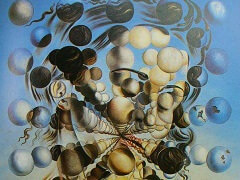Anthropomorphic Beach, 1928 by Salvador Dali

In keeping with the theme of erotic abandon (luxuriating, albeit grotesque, figures reclining on the beach) that had entered his work in 1928, that same year Dali executed a series of more abstract beachscapes with collage elements in which form is reduced to organic, biomorphic shapes inspired by the relief sculptures of Jean Arp. Anthropomorphic Beach, a fragment from a larger, now destroyed painting, belongs to this series.
The immediate precedent for kind of formal bricolage Dali employed in this series can be traced to the working practices of Joan Miro and Max Ernst, who both employed found materials from illustrated catalogues as points of departure for their imagery, and Picasso's "guitar" collages, which Dali is likely to have seen on the occasion of his first trip to Paris that year.
Anthropomorphic Beach renders explicit the subject of Dali's Bather and Beigneuse. The hairy finger pointing upward toward a soft, blood-red piece of sponge leaves little room for the imagination, as the finger/phallus association achieves its most concrete form to date in Dali's work. The obscene gesture may also have been intended as a reference to a familiar expletive - giving one the finger to register anger or displeasure - which Dali is likely to have directed at the conservative Catalan public and the Barcelona art establishment.























